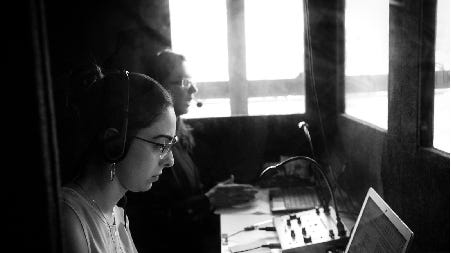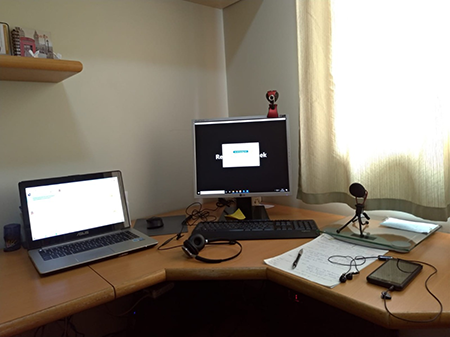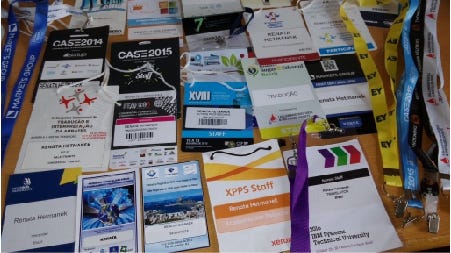Simultaneous Interpretation during Quarantine (published in March 2021)
mar 13 2023By Renata Hetmanek

This article was written in the beginning of 2021, at the high of the COVID quarantine. We have kept it as a vivid record of those sad moments.
The last time I worked as an interpreter in an on-site event was in March, 2020. It was a large convention held by a global credit card company, with dozens of tables neatly set with fresh flower bouquets, and a small bottle of alcohol-based hand sanitizer for each participant. I thought to myself: something is wrong here. I’d seen all kinds of small gifts to participants, such as USB drivers, pens, bars of chocolate, candies, customized bags, but, come on, hand sanitizers?

And then we all know what happened next.
All Events Were Cancelled
At first customers postponed all events to July, August, and September. Then the events were cancelled at last. As optimistic as I usually am, I just sat down quietly on my desk and kept working on my written translations. Everybody started talking about remote simultaneous interpretation, which is not something new, but was not so popular back then. It is still simultaneous interpretation, but not exactly as interpreters were used to doing before the quarantine. At least not most of us.
So, when the world was free for us to go back and forth as we pleased — I mean, before the apocalypse — a regular day for interpreters would mean get up very early, cross the entire city (as usually events are far from home), find a decent place to park the car for a reasonable price (usually as expensive as lunch), go to the event facilities, enter the interpretation booth, test the equipment with skilled sound technicians, have a brief conversation with the presenters and event organizers, make sure nobody would stand in front of the booth, so as to keep an eye on the presenters’ body language and do some lipreading whenever necessary, and, last but not least, translate whatever needed to be translated. In case anything went wrong on the technical side, such as a mute microphone on the presenter’s side, or undesirable noises in the room, we could always count on a smart qualified audio professional, who would quickly solve the issue.

As soon as the quarantine started in Brazil, in March last year, interpretation agencies and clients from different industries started to demand what is known as ‘remote simultaneous interpretation’ (RSI). That is, interpretation performed at the interpreters’ home office (in most cases) or in a small studio, or in a hub. The word ‘remote’ here is opposed to ‘on-site’. Because, nowadays, there is hardly anything ‘on-site’. The idea is to keep social distancing.
So, how different is that now? First and foremost, there is no team to support the interpreter ‘on-site’. Because nothing happens ‘on-site’. Everything is happening remotely. Everybody is connected via a software platform, a videoconference solution. And that is scary, I tell you.
My first self-defense strategy was to pretend I was dead. Before COVID-19, I refused to do remote simultaneous interpretation, alleging the only two things I was able to do simultaneously was listening and speaking in a different language at the same time. No technical concerns, please. But, then, fast-forward four months later and the news was still about the pandemics facts and numbers. Then I decided it was time to give in and go back to the battle field.
The New Booth
My home office was just perfect for written translation. However, it had to be adapted for remote simultaneous interpretation. I did some research with colleagues and found out I needed a proper headset with noise cancellation, in order to reduce noises coming from around the house, such as cars passing on the street, dogs barking in the neighborhood, lawn mowers, and the like. Checked.
I also needed to install the most popular videoconference software programs on my desktop PC and on my notebook, because they work better this way than when you just click the link and open the meeting. Checked.
I needed a microphone and a sound card to plug to my smartphone, in case the client asks me to use a different channel to translate a videoconference. Checked.
Also, I needed an alternate Internet provider in case my primary connection did not work. Checked.
I also thought it would be a good idea to stick some foam into my doorbell, to silence occasional visitors (mostly service providers delivering stuff these days), and to stick polite notes on my front door and on my window saying ‘Please, do not disturb’ to let my neighbors know I could not say ‘hi’ to them during work, not even for a second. Checked. Checked.

Oh, I do not have a cuckoo clock at home, but I am aware some interpreters had to take care of that, too. And the ones who have small children had to send them somewhere else, for obvious reasons.
OK, all that set, it was time to work. Most clients prefer to run a quick half-an-hour technical test a couple of days before the event to make sure all people involved have the right link to the meeting, and all equipment is working properly. Now, more than before, it is important for clients to provide interpreters with some support material to read and research beforehand.
Connection usually occurs half an hour before the event. Some videoconference programs have a special feature designed for interpreters, so participants can listen to the translation in a different channel. To work in pairs, as interpreters usually do, we make a separate call (using our smartphones) and, using an earbud, we can manage to listen to each other during the translation. (Yes, it is one more voice to listen to during work, but I only use that earbud when I am not the one who is translating.) We can talk to each other texting via WhatsApp Web (I prefer to use my notebook for that purpose), and that’s also how we keep track of time and prepare for handovers (when we switch to the other interpreter).
If the interpreter’s Internet connection fails to work, the second interpreter can start translating right away, until the first interpreter (hopefully) gets back on his/her feet.
Yes, there are a few clients who prefer to work with only one interpreter, to save money. I understand the economic reasoning. However, if the Internet connection fails at the time of the event, or if the power goes down during a storm (and we all know this could happen), then there will be no translation. So, I strongly advice hiring two interpreters for each language pair. I can assure it is not more expensive than it would normally be if hiring a regular team, which would include interpreters, audio technician, transmitters and individual radio receptors, a receptionist to distribute radio receptors, interpretation booth, speakers, microphones, additional batteries, booking conference rooms, providing coffee breaks, so on and so forth.
Is simultaneous remote interpretation better than traditional on-site interpretation? In my opinion, it is not. Many things could go wrong. The good thing is not having to drive miles and miles to get to the event facilities. But I am a social being, like most interpreters are, and I do miss all the buzz around conferences and conventions. I miss talking to people, looking at how they behave, how they dress, how they greet one another. I miss getting hints from body language when speakers are presenting. Anyway, right now it is not about being better or worse, it is just about addressing the situation as it is. Hopefully, the world will soon open its doors again.


Renata Hetmanek is a Brazilian translator, interpreter, journalist and voice actress. She has been working with LatinLanguages since 1995, playing different roles throughout these years (external editor, in-house translator, project manager and freelance translator).




